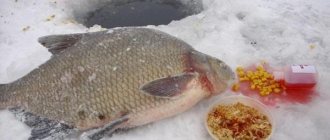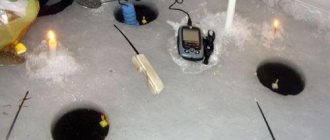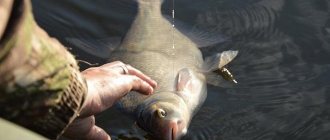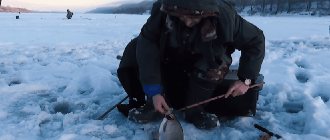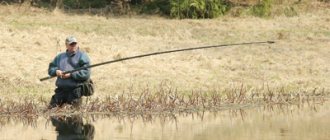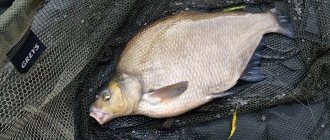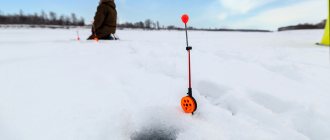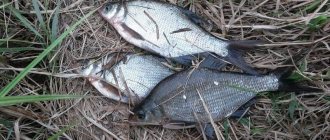What is an allowance
Podpusk is a type of bottom fishing rod, which has long been used for catching bottom river fish. The approach is designed for great depths and strong currents, which makes such fishing successful. The essence of the method is that the main line is fixed in a vertical position using a sinker, which is lowered to the bottom of the river. Several leashes with hooks are attached to the fishing line above the load. The water flow lines them up in one line, along which a fragrant train of bait also stretches from the feeder installed nearby.
Important! You should not use a slip in sections of the river with a characteristic whirlpool, so that the leashes do not get tangled with each other.
Submission fishing can be:
- active : the release is attached to the rod, the end of which signals a bite;
- passive : a catch tied to a buoy is left in the river, and the catch is checked from time to time by fishermen.
- Advantages of the method:
- the current carries away the leashes with hooks one at a time, so they do not get tangled with each other;
- used at different depths - from 2 to 10 m;
- applicable both in summer and winter.
"Koltsovka"
Launching in a strong current - this is how you can characterize this powerful tackle with a massive feeder on a strong nylon cord, which serves as a halyard for dumping the actual sliding bottom to the feeder at the bottom. The sinker of this sliding donkey is also a massive lead ring through which the main fishing line of the donkey is passed. Using special latches or passages in the ring, the feeder cord is placed into this kind of sinker. And after this, a ring with a long undergrowth is lowered along a cord onto a feeder lying on the bottom. The effectiveness of this clever bait for bream is that the leashes with hooks and bait are located exactly in the stream washed out of the bait feeder. There was even one period in the history of Russian fishing when, due to its catchability, “ringing” was considered poaching gear and was prohibited. This ban has now been lifted.
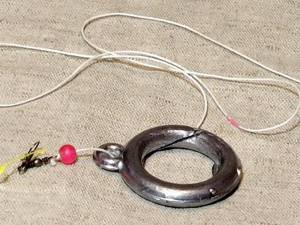
A good alternative to a massive ring that tightly ties the feeder cord to the main line of the feeder are the so-called “eggs”. These are two metal balls on a spring wire that move freely along the cord. They replace the ring, like a sinker, and are a detachable element when landing fish. And this makes it much easier and safer for the tackle to lift large bream from the bottom. During the current, the blind connection of the ring with the main line of the line often causes the break of the leash or even the entire undergrowth of the line, the length of which can reach 3 meters. With the inevitable jerk during hooking, the “eggs” are unfastened from the cord and fishing for bream or other large fish occurs in a free mode, as when fishing for fish on a spinning rod or other tackle.
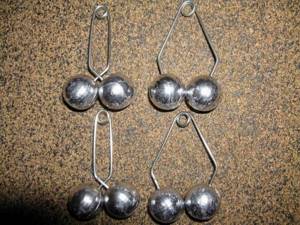
Other gear can be used from a boat in the current. Moreover, sometimes there is no other way out but to replace the “ring” with another bottom tackle. What is the reason for this often urgent need? After all, as we found out, “ringing” is a very effective and catchy tackle. It's all about the external fishing conditions, which can change dramatically due to a change in the operating mode of the Volga hydroelectric power station. That is, the current may completely disappear or weaken to the point that the three-meter undergrowth of the undergrowth will overflow around the cord of the feeder and cling to the feeder itself. A bream fishing can can be an excellent tackle in these new changed conditions. What kind of gear is this?
What does the tackle consist of?
The access equipment is quite simple.
Did you know? Bream is considered a non-migratory fish. In fact, Volga breams living at the mouth of the river go to the Caspian Sea for the winter.
Consists of the following elements:
- short hard rod 1 m long;
- inertial coil;
- monofilament line of three sections: main line - 0.4-0.6 mm, undergrowth - 0.3 mm and 3-5 leads of 0.2 mm each;
- hooks with long stings No. 6–10;
- sinker, the weight of which depends on the strength of the current (200 g and heavier);
- a bell that attaches to the top of a fishing rod to notify you of a bite.
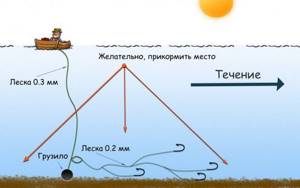
Many boat fishermen fish without a rod and reel. Instead, use a regular reel. In this case, you need to hold the fishing line between your fingers in order to feel the bite in time. For complementary feeding, a “jar” feeder is often used, connected to a weight, from which the complementary food is gradually washed out by the current, creating an appetizing trail along leashes with hooks.
How to make it yourself
It is not difficult to assemble the underpass with your own hands.
Find out also how to catch bream in September on a feeder.
To do this you need to follow these steps:
- Prepare a fishing rod from any hard material (bamboo, walnut) with a large reel. The length of the fishing rod depends on the fishing location: for fishing from the shore on a small river, a long rod (5–6 m) is suitable, for a boat - a short one (1 m), and for winter fishing - even shorter.
- A sinker is tied to the end of the main line, which is 10–15 m long.
- Above the load, 30–50 cm, is attached using a ring or simply tied undergrowth 2–3 m long.
- 3–5 leashes of 30–50 cm each with hooks are tied to the undergrowth at intervals of 1 m.
- You also need to take care of the feeder. If this is a “donka-can”, then it can be made from any can of canned food or condensed milk, making many holes in them with a diameter of 1 cm. The feeder is attached to the fishing line along with a sinker.

Catching burbot with a jig
Sometimes, in very cloudy weather, burbot is caught during the day when fishing with a jig baited with a bunch of bloodworms. For example, I once pulled out almost a kilogram of burbot on a 0.12 mm fishing line when I was catching perch on the deep edge of the Rybinsk Reservoir. My friend at the Ivankovskoye Reservoir in March last year, at a baited bream point, caught two burbots one after another in one day. It is interesting that the bites occurred at a depth of 11 m, while the surrounding depths were 12 m. A difference of just one meter gave an unexpected fishing result. Obviously, these predators can be active during the day in places where a lot of small fish are suitable for bait.
Where is the best place to catch bream?
Bream is a deep-sea fish; it rarely rises to the surface and does not swim close to the shore. It needs to be hidden at the bottom or in the water column. Therefore, most often it is hunted from a boat. But the inlet “works” only in places with strong and moderate currents.
Did you know? The lifespan of a bream depends on its habitat. In rivers they live only 10 years, and in stagnant water - 2 times longer.
Considering this, it is better to catch bream on the approach:
- from a boat on large rivers with strong currents, for example, on the Volga;
- from a steep bank in the presence of sufficient depth and fast flow;
- on small rivers, if there is a strong current, from a boat or from the shore, using a long fishing rod;
- in winter from the hole if there is a current.
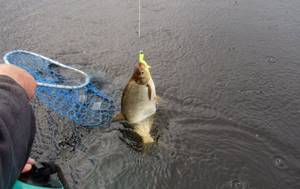
To choose a suitable place on a reservoir, you need to know the features of the topography of its bottom. Bream loves various irregularities: holes, mounds and other anomalies. That's where he needs to be kept in wait.
Catching burbot by knocking
On the Rybinsk Reservoir, this fishing method is quite common from January to March. I do not practice it for ethical reasons, since the burbot falls for this bait, protecting its spawning zone from any fish that is ready to encroach on the laid eggs.
“Knock” fishing is done using a large jig or jig head, weighing 20–40 g, baited with a bunch of worms or a piece of fresh fish. There are no special features in the playing technique here. The fisherman simply taps the bait on the bottom with short pauses. An ordinary fishing rod designed for trolling perch or pike. The bite feels heavy at the end of the line. Some anglers sit on one hole, waiting for the burbot to approach, attracted by the sound, others walk from hole to hole.
Choice of feeding
To feed fish, you can use purchased ready-made mixtures. But experienced fishermen prefer to make their own bait. Homemade mixtures are more economical, effective and tasty for fish.
Important! When compiling a menu for bream, it is imperative to include the ingredient that will be baited on hooks, for example, chopped worms.
The ingredients must be mixed in the correct proportion:
- major faction
— the main component that plays the role of bait (barley, corn, peas) — 50%;
- clay for mixture viscosity — 30%;
- medium and fine fractions (millet, breadcrumbs, flour or ground fried seeds, oat or corn flakes, cake) - 20%.

Natural flavors that bream loves are also added: anise, vanillin, cinnamon, coriander, honey, strawberry, garlic, etc.
In cold water, bream prefers live protein foods: worms, larvae, maggots and small crustaceans. In spring and autumn they should be included in nutritional mixtures. And in winter, you can simply pour a handful of bloodworm larvae or chopped worms into the hole. Balls are made from boiled porridge and clay, which are thrown into the feeding area before being immersed in the supply water. The feeder is also filled with the same mixture, which is lowered along with the sinker.
Techniques and tactics of catching
For fishing to be successful, it is necessary to correctly install the boat and equipment.
Important! When choosing a boat for bream hunting, it is better to give preference to the quietest option. When moving, an inflatable boat makes the least noise and does not scare suspicious fish.
Procedure:
- Secure the boat in the chosen place with two anchors (on the bow and stern).
- Feed the place, taking into account the direction of the flow (if there is no stationary feeder).
- Alternately bait the hooks and lower them into the water, starting with the last one.
- When all the leads are already under water, lower the sinker, tighten the main line and attach a bell to the top of the fishing rod.
- Lower the stationary feeder (if provided) from the opposite side of the boat to the bottom. This could be a mesh bag filled with feed mixture, with a stone inside, which is tied with a rope.
- When the bell signals a bite, the fish needs to be hooked and reeled out.
Video: fishing on the approach

When fishing passively (at night), the main line is disconnected from the rod and attached to a massive buoy. The installed structure is left overnight, and in the morning the fisherman checks the catch.
Pay attention to the difference between bream and white bream.
Podpusk is a very catchy tackle in fast and deep river conditions. You can use it to catch not only bream and bream, but also ide, burbot, perch, pike perch and catfish, as well as other peaceful and predatory fish.
Access and crossing
When going fishing for the night or for a longer period, in the case where a hauling line with heavy loads is installed from a boat, you can use it quite quickly and without much difficulty to install a drop or a line for the night on the entire number of hooks allowed by the rules.
At one end of a 100-meter fishing line with a diameter of 0.6-0.7 mm, an end loop and 10 loops for attaching leashes are tied. The distance between the loops is 2-2.5 m. The fishing line is wound on a reel. mounted on the bottom of two knees of a rigid bamboo rod (the third knee is removable).
The looped end of the line should be wound last. A strong hook made of wire with a diameter of 4
-5 mm (Fig. 60).
Rice. 60. Rod with reel and hook
It is necessary for raising the fishing line when sending live bait or other bait to depth, as well as when attaching caught fish. Ready-made leashes 40-50 cm long (preferably made from thin, strong fishing line) are attached to the loops using steel fasteners (Fig. 38).
When installing the rewind, the right (downstream) fishing line with the feeder is disconnected from the locking unit, the freed fishing line is reeled in, and together with the reel is removed from the device. Instead of this fishing line, the end of the strap with rings for leashes is tightly attached to the locking ring.
Further equipment of the reel is carried out in the following order: a leash is attached to the loop on the fishing line, a hook is baited, and the nozzle is sent into the water using a constriction, at the same time part of the fishing line (up to the next ring) is removed from the reel, the next hook is baited, lowered into the water and pulled away from the reel by the constriction shores.
While the leashes are moving from the shore, the reel line (to avoid snags) is raised to the top with the tip of the rod.
After baiting all the hooks, the net is sent from the shore to a pre-designated place. The drag reel is braked and both rods are firmly secured to the shore.
It takes two people to catch fish, working in concert with both rods. If necessary, the fishing line can be lifted up with the hook of the rod. A landing net or hook is required.
The leashes that are released as the fishing line is wound on the reel are either removed from the fishing line or reeled together with the fishing line on the reel. At the same time, the free hooks are stuck into an elastic band that was previously glued to the front part of the reel bar.
You can also remove the caught fish from the line from the boat, after having pulled the hooks with the fish closer to the shore.
Entrance. Also. as in the saddle, an end loop is tied on a 100-meter fishing line with a diameter of 0.6-0.7 mm, to which a piece of foam is attached. Then, every 2-2.5 m, 10 loops are tied for the leashes, and 5 m from them - another, larger loop for connecting the lead (cord) with the constriction ring, from which the right fishing line with the feeder is already disconnected.
The hook-free line should be wound on the rod reel. The underpass will differ from the net in that a large piece of foam plastic is connected to its end, which, when lowered into the water and floating freely with the current, will stretch a fishing line with hooks along the river, and near the locking ring some of the hooks will be closer to the bottom, and near the foam plastic - closer to the surface of the water. Thus, the hooks will be evenly distributed throughout the entire water column. Hooks can be baited with a wide variety of bait.
When fishing for fish, they try to pull the locking ring ashore and disconnect it from the release line, after which the fish is brought to the shore using a rod with a reel.
Section XIV (“Underwater constriction«
), according to the authors, deserves special attention from fishermen for many reasons. One of them is the absence of any original specific developments of this topic both in our and in foreign literature.
But the main thing, perhaps, is not the «
Hauling
“,
and for a variety of fishing methods that can be implemented in combination with hauling. Let's look at some examples.
Near especially catchy places, a large number of fishermen sometimes accumulate on a convenient section of the river bank.
Frequent noisy casting of feeders and heavy weights, sudden movements of people waving powerful rods in full view of the fish, certainly scare it away from the fishing spot.
In this case, find a section of the bank overgrown with bushes, from which, by all indications, it is impossible to fish with a fishing rod or bottom . In a convenient place (upstream), install a constriction on the bank and, without any interference, in complete silence (except for the splashes of fish), without In a hurry, calmly fish the section of the river located downstream.
Another example
Large fish do not tolerate the close, and sometimes even not very close, presence of a person or any object unfamiliar to it.
Once on the Oka, during a long fishing trip to the area of Richter’s dacha, about 30 m from our tent near the very shore in the same place before sunset, noisy splashes of asp were heard.
As soon as you got a little closer to the place of his battle, everything immediately stopped. Of course, he saw us perfectly well on the open shore and at the slightest careless movement he went into the depths.
Then we stuck a strong fishing rod into the edge of the bank, from its tip we lowered the roach into the water and did not approach this place any more. However, the asp seemed to have disappeared somewhere; no splashes any longer indicated his close presence.
And only on the third day in the morning, having obviously gotten used to the end of the fishing rod bent over the water, he took the bait.
To you. Surely, you won’t have to wait so long for the asp to bite if he suddenly starts a noisy hunt for fish in the zone of action of the constriction, equipped with a float with a dragonfly, grasshopper or cockchafer.
Example three
Recently I happened to observe such a picture from the outside while fishing with rods from the shore.
Two of them cast the bait 30-40 m from the shore, and only the third one pulled out the bream, who, next to them, caught them 60 m from the shore. The banner, especially installed from a boat, will allow you to easily deliver the bait to where the third one was fishing.
It is impossible not to say one more thing. It is difficult to imagine how one can fish the coastal zone of a river near bushes hanging over the water, thickets of water lilies, a solid wall of reeds or reeds from the side of open water without a boat, that is, without the direct presence of a person in sight of the fish, which are often “comparatively located in these places.” shallow depth.
A special float connected to a constriction towing line will allow you to control the movement of the nozzle in a given place from afar, leaving a person out of sight of the fish.
In addition, with the help of a towing line, a fish caught on a hook can be brought out of the “dangerous” zone (away from the thickets) into clean water, and then, after giving it the opportunity to “walk” in freedom, working alternately with the reels of the tug and fishing rod, bring it to shore.
Generally speaking, “underwater hauling”1 could well be the subject of a completely separate conversation, since many other methods of catching both predatory and non-predatory fish can be associated with it. There is an unlimited choice here to implement a lot of new fishing ideas and proposals.
The gear was tested over just one partial fishing season and therefore much of it, obviously, can be supplemented and improved.

